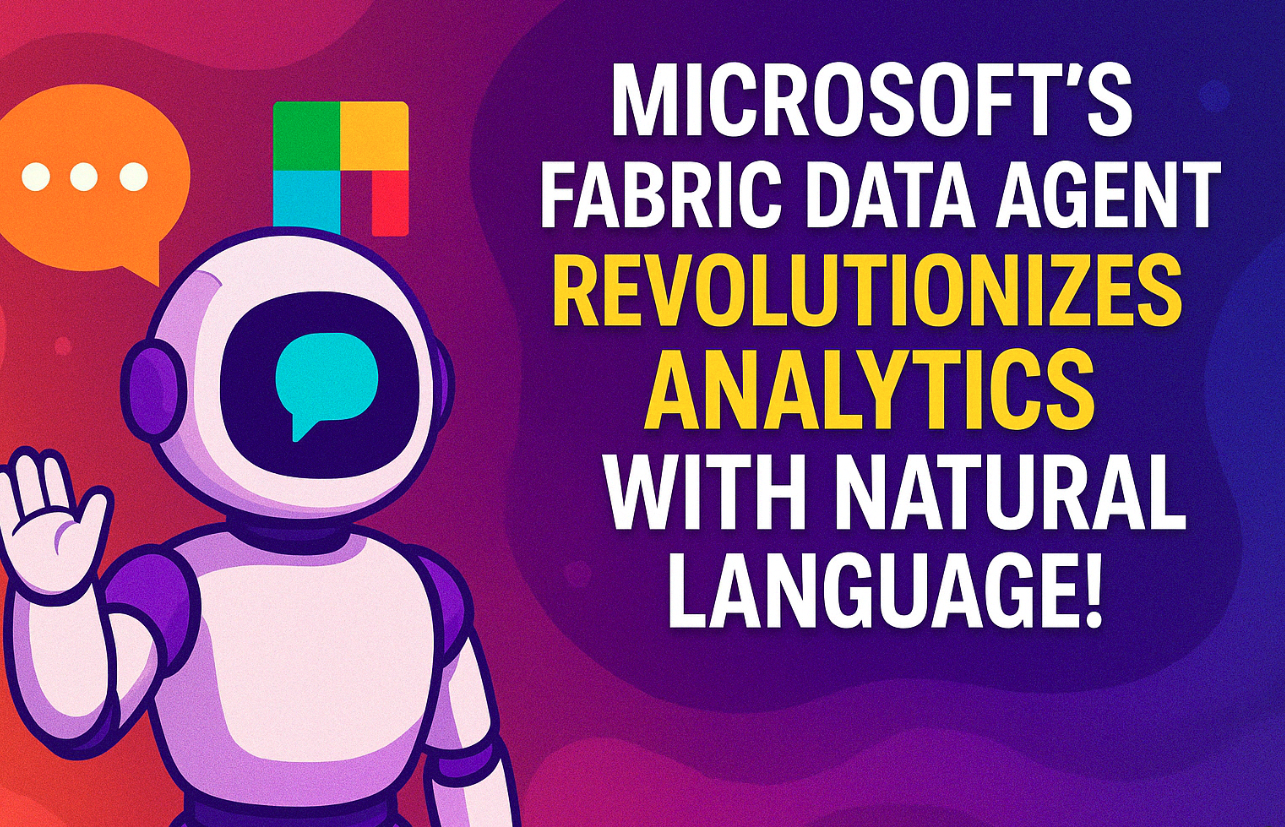Microsoft's Fabric Data Agent Revolutionises Analytics with Natural Language!
Imagine a world where data analytics isn't limited to experts skilled in SQL, DAX, or KQL queries—where accessing actionable insights from complex data sources is as simple as asking a question in plain English. Microsoft is turning this vision into reality with its innovative Fabric Data Agent, an exciting new feature in Microsoft Fabric that empowers every employee within an organisation to engage effortlessly with data, fostering a truly data-driven culture.
What is Microsoft Fabric Data Agent?
Fabric Data Agent is a groundbreaking feature integrated within Microsoft Fabric, enabling organisations to create intuitive conversational Q&A systems using advanced generative AI. Leveraging Azure OpenAI Assistant APIs, it processes plain language queries and automatically generates structured queries across multiple data sources, such as warehouses, lakehouses, Power BI datasets, and KQL databases.
Fabric Data Agent bridges the gap between users and their data, allowing anyone, regardless of technical expertise, to retrieve precise, context-rich information without ever writing a single line of code.
How Fabric Data Agent Transforms Data Interaction
Fabric Data Agent transforms traditional data interaction through several key stages:
1. Question Parsing and Validation
When users ask questions, the agent employs Azure OpenAI Assistant APIs to parse and validate these queries. This process ensures compliance with organisational security policies, responsible AI standards, and user-specific data permissions.
2. Data Source Identification
Fabric Data Agent intelligently identifies the most appropriate data sources (lakehouses, warehouses, Power BI semantic models, or KQL databases) based on user credentials and query context. It accesses only schemas and structures the user has permissions to view, ensuring data security and privacy.
3. Query Generation
Once the relevant data source is identified, the agent translates the natural language query into structured queries using specialized tools:
NL2SQL: For relational databases such as warehouses and lakehouses.
NL2DAX: For Power BI semantic models.
NL2KQL: For KQL databases.
This automation removes the need for users to possess technical query-writing skills.
4. Query Validation and Execution
Generated queries are validated against security and responsible AI policies. Once validated, they are executed on the selected data source. Responses are then delivered in structured, easily understandable formats such as tables, summaries, or key insights.
Configuring Your Fabric Data Agent
Setting up a Fabric Data Agent mirrors the simplicity of designing a Power BI report:
Selecting Data Sources: Fabric Data Agents support up to five sources simultaneously, providing extensive flexibility to include lakehouses, warehouses, Power BI semantic models, or KQL databases.
Choosing Relevant Tables: Users pinpoint specific tables within selected sources to ensure accurate and relevant responses.
Adding Contextual Instructions: Organisations can further enhance agent accuracy by providing tailored instructions and illustrative example queries. This customisation ensures that responses align precisely with organisational terminology, preferences, and data handling guidelines.
Fabric Data Agent vs. Copilot: What's the Difference?
While both Fabric Data Agents and Fabric Copilots leverage generative AI, key distinctions set them apart:
Customisation: Fabric Data Agents offer extensive configurability with custom instructions and examples, whereas Fabric Copilots are preconfigured with limited customisation capabilities.
Application Scope: Fabric Copilots primarily assist with tasks internal to Microsoft Fabric, such as notebook code generation. In contrast, Fabric Data Agents function as standalone tools and can integrate seamlessly with external platforms like Microsoft Copilot Studio, Azure AI Foundry, or Microsoft Teams.
Real-World Applications of Fabric Data Agent
The transformative power of the Fabric Data Agent extends across multiple scenarios:
Business Intelligence: Employees across all departments can now directly query data to support their decisions, boosting overall productivity and strategic alignment.
Financial Analysis: Simplifies complex financial queries by allowing non-technical users to easily obtain financial metrics and trends, supporting better financial decision-making.
Operational Efficiency: Organisations reduce dependency on technical staff for everyday data queries, improving operational efficiency and resource allocation.
Ensuring Quality, Safety, and Reliability
Microsoft has rigorously tested the Fabric Data Agent through comprehensive benchmarking across various public and private datasets to ensure high accuracy and relevance. Additionally, enhanced harm mitigation features keep outputs secure and contextually relevant.
Current Limitations and Recommendations
Despite its groundbreaking capabilities, Fabric Data Agent, currently in public preview, has some limitations:
It cannot interpret complex analytical trends or underlying causes.
It strictly generates read-only queries (no data modifications).
It supports English-only interactions and cannot access unstructured data resources like PDFS or Word documents.
Optimal performance occurs with up to 25 tables across all selected sources and using descriptive naming conventions for columns and tables.
Users are encouraged to rigorously test and fine-tune their Fabric Data Agents to enhance performance and reliability.
Looking Forward: The Future of Conversational Analytics
The introduction of the Fabric Data Agent marks a significant shift toward accessible, democratized data analytics. As this technology matures, we anticipate further improvements, including:
Enhanced multilingual support.
Ability to handle increasingly complex analytical queries.
Expanded data source integration.
Ultimately, Fabric Data Agent is not just an innovative tool—it represents a powerful shift toward an inclusive, data-driven culture where insights are universally accessible and actionable.
Embrace the Fabric Data Agent Revolution
Microsoft’s Fabric Data Agent signifies an exciting leap forward in data analytics, offering unprecedented ease, flexibility, and accessibility. Organisations embracing this technology will find themselves at a strategic advantage, equipped with tools that empower every team member to interact confidently with data and drive impactful business outcomes.
Harness this revolutionary approach to analytics—start exploring Fabric Data Agent today and transform how your organization leverages data for decision-making.
